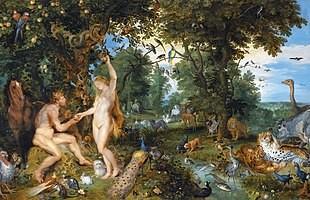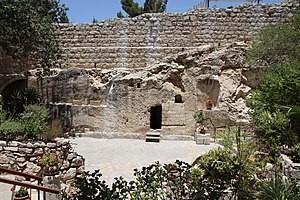The carbon dating of domesticated plants indicated these were native to this area and that horticultural activity began here in 9000 BC. The plants grown were cereals and pulses, but this activity was nearer to farming than gardening whereby the people used rudimentary tools such as sticks to create drills for the plants to grow. The invention of the plough, trowels and spades was some time into the future.The Biblical story of the Garden of Eden is perhaps the most famous garden of all and is where Adam and Eve ate fruit from the tree of the knowledge of good and evil. As God had forbidden them to eat from this tree, Adam and Eve and, consequently, humanity was thrown out of the paradise created by God and doomed to suffering sin and great unhappiness. The Bible portrays the Garden of Eden as a place of great peace and serenity which had a huge number of plants and animals. Maybe gardens are an attempt by humans to replicate the peaceful, bountiful, and spiritual place from which they were expelled.

The Garden of Eden with the Fall of Man by Jan Brueghel the Elder and Pieter Paul Rubens c 1615
Other gardens in the Bible include the Garden of Gethsemane where Jesus endured severe mental trauma and anguish as he knew what was going to be betrayed and crucified. The Garden of Gethsemane is a place of great significance for Christians due to the suffering of Jesus. It is located at the base of the Mount of Olives in East Jerusalem and consists of several small olive groves. Several churches claim to be the site of Gethsemane, and these are the Catholic Church of All Nations, the Church of the Sepulchre of Saint Mary, the Greek Orthodox Church and the Russian Orthodox orchard next to the Church of Mary Magdalene. The Church of All Nations site appears to be the original Garden of Gethsemane which was erased by the Romans in 70 A.D. when Jerusalem was captured and destroyed. The third Biblical Garden is the Garden of Golgotha (also known as the Garden Tomb) which is next to Golgotha, a hill believed to be the location where Jesus was crucified. The Garden Tomb is believed to be where the body of Jesus was placed in burial chamber cut in to the rock. It was also the place where Jesus rose from the dead in the Resurrection. The word Golgotha is an Aramaic word meaning “the skull” as the hill where Jesus is believed to have been crucified does look like a skull.
The Garden of Golgotha/Garden Tomb in Jerusalem
There is, however, much debate as to the exact location of the crucifixion of Jesus and Golgotha seems to be favoured as the site by numerous Christian groups such as the Evangelicals. The term garden also seems to be a misnomer as at the time of the crucifixion of Jesus it was more likely to be an olive grove.One of the Seven Wonders of the Ancient world was the Hanging Gardens of Babylon. The gardens were believed to be sited near the royal palace of Nebuchadnezzar (King of Babylon from 605-562 BC) for his wife Amytis, in the city of Babylon, the capital of Babylonia, located between the rivers Tigris and Euphrates in southern Iraq. The gardens are believed to have been a series of landscaped tiered terraces though the Hanging Gardens could also have been planted roof top areas. The gardens would have been watered by a series of irrigation channels as the river Euphrates was nearby and this would have allowed the gardens to bloom in an arid desert region. Amytis was believed to have been very pleased with the gardens as they were reminiscent of her native Media.The plants in the Hanging Gardens of Babylon would have included olives, quince, date palms, almonds as well as imported plants such as cedar, cypress, pomegranate, plum and juniper. Many of the plants would have hung over the edges of the tiered terrace walls suggesting the name Hanging Gardens of Babylon. Another type of garden with links to the Garden of Eden is the paradise garden which appears to have been created during the reign of Cyrus the Great who established the Achaemenid Empire or First Persian Empire in 550 BC. The paradise gardens were based on Old Iranian designs and consisted of a formal design with symmetrical features and usually enclosed. The most traditional format of these gardens was a long rectangle separated into four quarters with a water feature in the centre, usually a pond.
Schematic of a Paradise or Persian Garden
This type of garden design is known as a chahar bagh (four gardens) and can include canals and fountains. The central pond feeds the four rivers/garden canals which flow into the wider garden/world and are symbolic references to the Garden of Eden. Aromatic flowers and fruit trees were considered essential to the paradise garden and included olives, figs, dates and pomegranates which may have featured in the Garden of Eden itself.So, whether you own a country estate with formal gardens or a window box and terracotta pots in a high-rise block of flats, the garden is a place of peace, tranquillity and maybe a subconscious yearning for a return to the Garden of Eden.Thanks for reading the blog and poem and please leave a comment as they are all appreciated.England’s Garden of Eden
The garden is gone. Lost under a sea of
cement, streams of Stygian tarmac and
stilts of steel covered in glossy glass shrouds.
Farmland lies flattened under miles of
pointless paving stones, forests felled,
grass, trees, wildlife now digital
memory, fading from collective
consciousness.
Still, they build, build, build, build,
endless drab housing estates and
high-rise pack ‘em and stack ‘em
oblongs that populate, proliferate.
Nature no longer nurtured, food no
longer grown, seeds no longer sown.
Flames flicker on the horizon as
people realize the garden is gone
and it isn’t coming back.
Thanks for reading the blog and poem and please leave a comment as they are all appreciated.Dermot Moroney Email ThisBlogThis!Share to TwitterShare to Facebook
